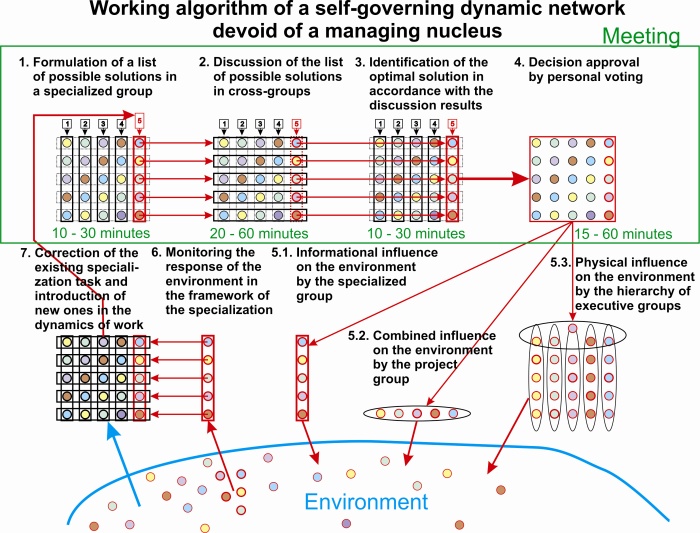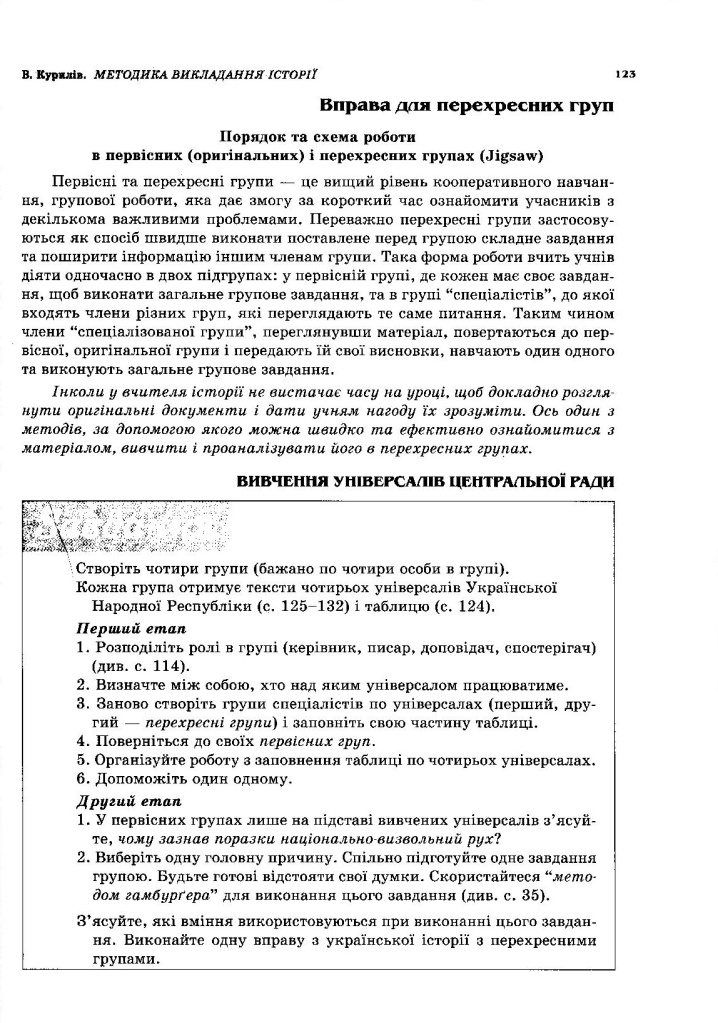Самоврядна динамічна мережа як ефективна альтернатива ієрархічній будові суспільно-політичних організацій
Самоуправляющаяся динамическая сеть как эффективная альтернатива иерархическому строению общественно-политических организаций (перевод на русский – в процессе подготовки)
A Self-governing dynamic network as an effective alternative to the hierarchical construction of socio-political organizations
(The English text of the video-presentation)
A self-governing dynamic network includes a managed nucleus designed to organize the purposeful synchronized activity of large groups of people as an alternative to the rigid hierarchy that serves as the basis of most existing socio-political organizations. Young activists representing different NGO’s [Non-governmental organizations] offered their help with the presentation of the working algorithm of such a dynamic network.
Let us consider the construction and activity processes of a typical socio-political organization. When a number of active citizens meet and they share similar views of the actions to be undertaken to improve the society, to make it better, more humane and fair, they establish an NGO that with time stands a chance to develop into a massive movement or a political party.
The membership of such NGO’s may subsequently increase. The increase rate depends on the demand for the ideas enunciated by its policy documents. When the number of members exceeds 15–20 individuals, the organization loses the ability to effectively generate, adapt and carry out decisions aimed at achieving the declared objectives.
This makes members of the organization resort to a hierarchical structure. As a rule, they choose the Administrative Board and the Head, who are supposed to generate and make key decisions. It is implied that the other organization members will carry them out obediently. Under these circumstances, important information circulates only within the managing nucleus, while common members receive it in pieces, i.e. it is fragmented, which prevents them from seeing the comprehensive picture of what is going on. This is why they eventually focus their attention on other interesting things happening around them.
This leads towards growing passivity of most rank-and-file members, the lack of motivation to carry out leaders’ decisions and actively participating in the activities of the socio-political organization. Even if the organization goes on with it’s activities due to the charisma and energy of its leaders, its hierarchical construction, however, entails bureaucratization of its top in accordance with the “iron law of oligarchy” by Robert Michels. Apart from this, information monopoly gives the leaders the opportunity to manipulate with options available, for instance, to knowingly offer during meetings, conferences or conventions the decisions that are only beneficial to the managing nucleus. It should be pointed out that this behavioural scheme is conditioned by the positions of leaders in this particular role that is invariably replicated by the hierarchical structure rather than by their personal traits.
Another major drawback of socio-political organizations is their being extremely prone to fail under external control. This happens when a more dominant organization seizes powers by influencing the leader or certain members of the managing nucleus in a number of ways.
It should also be pointed outthat people who rise vertically such hierarchical organizations are usually far from the best, since members with more varied behavioural schemes stand a better chance of advancing themselves as they are ready to do it, regardless of any moral and ethical constraints. These drawbacks lead to the never-ending splits within Ukrainian political parties and NGO’s resulting in marginalization and denigration of democracy which discredits the very idea of civil society.
These processes have recurred in different socio-political organizations throughout all of the human history as a result of the lack of understanding or the suppression of the faults of such hierarchical constructions. Just think whether anybody has ever mentioned the “iron law of oligarchy” by Michels when you enter political parties or NGO’s. However it is described in many political science handbooks for higher education institutions.
The hierarchical structure of socio-political organizations, by the way, is secured by the Ukrainian legislation in the form of compulsory requirements to their statutes. The dominance of a hierarchy in the structure of downstream links of the socio-political organizations is effecting this System which calls for quality changes by the introduction of a network element and consolidation through certain types of statutory activity.
One alternative to the hierarchical structure is a self-governing dynamic network, without the managing nucleus, designed for the purpose of organizing effective synchronized work of big groups of people.
Let us proceed and directly demonstrate the algorithm of the workings of a dynamic network which was exemplified by a meeting of a socio-political organization with three types of program objectives. These types in our program will be symbolically represented by boxes of various colors.
Every category of objectives are developed by a specialized working team consisting of members who are the most competent in that area or the most willing to achieve the corresponding goals.
To better illustrate the distribution of the participants in specialized teams and their further restructuring, they will wear covers with different color’s. Each color will be in accordance with the color of the boxes that stand for the activity and objectives.
The cover number corresponds to the cross-team where every meeting participant will work at another stage of the algorithm.
The scheme exemplifies the breakdown of members of a socio-political organization into different functional groups to arrange their activity according to the work of the two-dimensional dynamic network algorithm.
Let us start our meeting. In our case there are 15 participants. They are subdivided into 3 specialized teams and 5 cross-teams. With growth of the organization, the number of specialized teams as well as the number of participants may go up. Conducting a meeting of more than 70 members and up to a few hundred, requires the application of the working algorithm of a three-dimension dynamic network, which requires a few additional steps.
The scheme represents the work algorithm of a two-dimensional dynamic network. Its cyclical duplication makes up the foundation of a socio-political organization’s activity. Every step of the algorithm may last from 20 to 60 minutes depending on the complexity and scope of the issues to be discussed.
At the initial stage, the participants are arranged into specialized teams to analyse the external information. They also generate and write down in their personal minutes a set of likely alternatives in their activity to achieve the given objectives or, in other words, possible solutions of the given tasks to the corresponding objectives. With this purpose the participants apply various methods such as brainstorming, and basics of the inventive problem solving theory, etc.
This first step results in generating a list of options in the personal protocol kept by every specialized team member.
Maintaining a protocol is a necessary condition for a successful activity of a dynamic network – this allows lossless propagation of information, obtained during restructuring of the group into other types.
Thus, the quality level of the final decision considerably depends on how well each participant performs his communicative function.
On the next step of the algorithm, the participants are restructured into cross teams which include one member from each previous specialized group. One by one they tell their colleagues about the alternatives they have generated and listen to their remarks, comments, suggestions and new ideas. Apart from this, they analyse the level of support for each alternative on the part of members of other teams and its chances to be accepted by general vote.
The second step results in generation of a list of remarks, comments and suggestions concerning the options generated in specialized groups, as well as a list of new alternatives (if any) of each participant’s personal minutes.
The third step of the working algorithm of a dynamic network implies discussions in the initial specialized teams, where the previous stage information (criticism, comments, suggestions and proposals concerning the list of alternatives) are being analysed and generalized.
Based on this, the final draft decision is prepared which must meet the requirements prescribed for such documents.
The result of work from the third step is a project of optimal solution, one that comprises the attributes required for its successful implementation.
At the fourth step, in a plenary session, the final solution projects of specialized teams are presented to the participants who either approve or vote them down by qualified majority without any debate. The plenary session results in a protocol of the meeting that includes description of approved or dismissed decisions.
The fifth step of the algorithm implies the implementation of the solutions in accordance with their attributes.
This can be of two types:
The first type involves the creation of analytical materials and disseminating them in the information environment in order to familiarize the target audience with them.
The second type of decision implementation consists in actual practical action of hierarchically structured groups headed by coordinators, who, in their turn, are subordinate to an executor in charge for each specific decision in accordance with the attributes of its formulation.
In our presentation, different color geometrical figures (triangles, squares and circles) attached to the participants’ arms indicate what executive group they belong to.
The next complex of measures implies receiving and analysing the external environment’s response to the organization’s decision implementation activity, adjustment of the tasks of specialized teams and posing new tasks in accordance with the existing plans of accomplishing strategic and tactical objectives worked out at the previous stages of activity.
Duplication of this working algorithm in time corresponds to John Boyd’s OODA loop, which implies a consecutive fulfilment of individual activity processes, i.e. observation, orientation, decision making and action. Herein the awareness and comprehension of the course tasks is ensured by specialized teams, intensive communication among all the participants takes place in the cross-groups and the organization’s active capacity is assured by all executive groups led by responsible individuals.
Hence socio-political organizations constructed as a self-governing dynamic network have a changeable structure such as information analysis, decision generating and decision making taking place in an orderly horizontal network, while the executive hierarchy that deals with their fulfilment.
We wish you every success in your public, socio-political activity!
Прототип динамічної мережі:
Коментарів ще немає.
-
Архіви
- Вересень 2023 (1)
- Січень 2023 (1)
- Липень 2022 (2)
- Травень 2022 (1)
- Квітень 2022 (1)
- Грудень 2021 (1)
- Жовтень 2021 (1)
- Серпень 2021 (1)
- Червень 2021 (2)
- Березень 2021 (1)
- Листопад 2020 (1)
- Жовтень 2020 (1)
-
Категорії
-
RSS
Entries RSS
Comments RSS



Залишити коментар